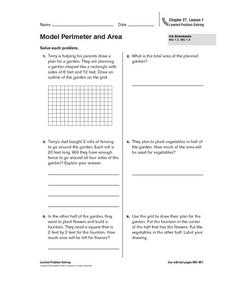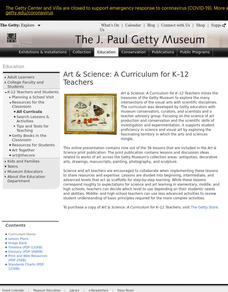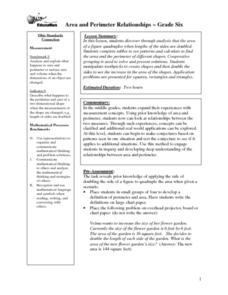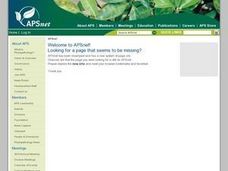Curated OER
Hollie's Gigantic Garden
In this math puzzle worksheet, students put their problem solving skills to use as they fill in the plant growth charts that require them to write and solve equations.
Horticultural Society of New York
Dress Up Your Salad
Salad dressings use a variety of different ingredients, but it's important to have a healthy balance of greens to create a delicious mix. Young chefs examine five types of herbs including chives, basil, dill, parsley, and thyme to make a...
Chicago Botanic Garden
Plant Phenology Data Analysis
Scientists monitor seasonal changes in plants to better understand their responses to climate change, in turn allowing them to make predictions regarding the future. The last activity in the series of six has scholars analyze BudBurst...
Curated OER
Dalmatian Picture Writing Prompt and Stationary
In this Dalmatian picture writing prompt worksheet, students look at colorful clip art picture of a dog in a flower garden. They write a story about the picture on the lined stationary.
Houghton Mifflin Harcourt
Model Perimeter and Area
Gardens seem to be the go-to for area and perimeter word problems. In this assignment, gardening consultants advise Terry, who is helping his parents plan for planting. They draw the outline of a garden on a grid and then perform...
Curated OER
This I Can Do: The Drive
Learners read The Garden of Happiness and discuss the importance of the common good in a community. In this common good instructional activity, students understand how overcoming diversity and working together for a neighborhood drive....
Curated OER
Getting to Know You
Students participate in tactile and visual exploration. In this tactile and visual exploration lesson, students listen to John Archambault's, Grandmother's Garden, and sing the song, "Friends Are Like Flowers." They participate in ice...
Curated OER
The Magic School Bus Goes to Seed
Young scholars learn along with Ms. Frizzle's class. In this Magic School Bus lesson plan, students get a bugs-eye view of the flower world and find out how seeds are created, how they travel, and how they grow into plants.
Curated OER
Growing Plants in Science and Literature, More Than an Empty Pot
Students read The Empty Pot as an introduction to plants. In this planting lesson, students understand a sequence of events in the book and relate it to the sequence of a plants life. Students grow plants and record information in flower...
Curated OER
Next Year's Seeds
Students play a game that demonstrates variables that affect farming. They write letters requesting free seed catalogs. They discuss the saying "A penny saved is a penny earned" in relation to what they learned from playing the attached...
Curated OER
Clearly Classified
Young scholars review the classification system for living organisms and apply it the classification of insects and flowers in the still life by Ambrosius Bosschaert. They create a chart classifying the animals and plants in the painting...
Curated OER
Classifying Plants and Insects
Art and science come together in a lesson based on Flower Still Life by Ambrosius Bosschaert the Elder. Learners classify plants and insects in the painting by color, leaf shape, size, reproduction, and season of bloom.
Curated OER
THE PEANUT WIZARD
Students read information about George Washington Carver and outline the information. They are given peanuts in the shell, students examine them and eat them. Students discuss the following questions: Why did George Washington Carver...
Curated OER
Poetry Book-- Small Creatures
In this reading instructional activity, learners create a book of poems about small creatures of the garden by stapling 20 pages. Students read each short poem and color the pictures.
Nemours KidsHealth
Self-Esteem: Grades K-2
Second graders create a flower where each petal has their talents and unique qualities on the flower. For this self esteem lesson plan, 2nd graders understand that they are all special in their own way.
Curated OER
I Can See the Sun
In this reading learning exercise, students learn the sight words "I can see" as they make an 8 page book about their sense of sight. Students read about what they see in a garden, then color the pictures.
Curated OER
Guided Reading with Hello Flower
Learners are introduced to the book and vocabulary through a group discussion. They view the book cover and predict what they expect the story to be about. Students read the book orally with the class. After a discussion, they whisper...
Curated OER
Garden For Life
Students are read a story about a girl their age helping others. They discover they can have a positive impact on others. They decide on a project related to literature that benefits the school or community.
Curated OER
I Can Sing a Rainbow....
In this Blakesley Hall Museum gardens worksheet, students view eleven pictures of garden flowers and learn the words to a garden song.
Chicago Botanic Garden
Preparing for Project BudBurst
Male deer growing antlers to begin the breeding season is an example of a phenological event. First in a four-part series is an activity requiring individuals to collect phenological data on their campus. Classes discuss phenology, the...
United Nations
Compost Monitor Training
What should go in the trash, and what can be composted? Guide your young conservationists through the process of composing their trash with a lesson about the different ways we can dispose of garbage. Using a trash bag with clean...
SF Environment
Pre-School Composting and Recycling!
You can never be too young to get involved in composting or recycling. Here is a lesson that has been made for the very littlest learners and it's all about the importance of conservation. They'll sort compostable and recyclable objects,...
Curated OER
Area and Perimeter Relationships
Sixth graders explore the relationship between area and perimeter. After discovering the definition of perimeter, 6th graders work together to create designs for a flower bed. They observe that the perimeter remains constant even...
Curated OER
Plant Parts and Their Diseases
Students see how certain plants are very important to us. They explain that healthy plants are important to keep people healthy. They study the major parts of a plant (root, stems, leaves, flowers, fruit and seeds) and their basic...

























